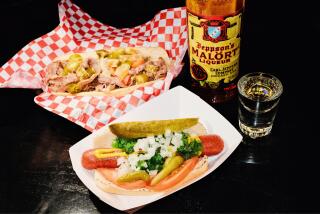Preparing meat worth its salt
- Share via
CHICAGO — Others may identify this time of year with the last gasp of winter, the return of baseball, even the Ides of March.
For those in the meat business, however, the approach of St. Patrick’s Day can mean only one thing: It’s corned beef season.
Production lines have been working overtime for weeks, and restaurants and grocery stores are laying in extra supplies of the specially cured beef as Saturday’s holiday draws near.
Corned beef and cabbage is about as pure Irish a holiday dish as green beer. But with millions of Irish Americans and Irish wannabes partaking of it on and around March 17, that means plenty of green for businesses that help get the star product from beef plant to customer’s plate.
After all, as Barbara Sidman put it after eating a heaping portion for lunch at Manny’s Coffee Shop & Deli in Chicago: “It wouldn’t be a holiday without corned beef, and corned beef is twice as good on the holiday.”
It’s better than that for Vienna Beef, the venerable Chicago meat company known best for its hot dogs.
Vienna Beef has been peddling franks since Austro-Hungarian immigrants and company founders Emil Reichel and Sam Ladany introduced the Chicago-style dog at the 1893 World’s Fair. It sells $50 million worth of hot dogs annually and about $15 million of corned beef. But from late January to the second week of March, corned beef production accelerates as workers shift over from soups, sausages and other deli meats to help with the St. Patrick’s Day rush.
All told, half the company’s annual volume of 3 million pounds of the salty beef is churned out during the hectic six-week period.
Corned, or brined, beef traditionally is a brisket taken from the lower forequarter of a steer. The brine makes it red.
But non-devotees may not know the myths behind the meat. For starters, its roots as a holiday dish are in New York City, not Ireland, where traditional St. Patrick’s Day meals are likely to feature boiled bacon instead. Irish immigrants substituted corned beef for bacon in the late 1800s to save money and it caught on.
And lest there be any doubt, there’s no corn in corned beef. The name goes back to a time before refrigeration and refers to the kernel-sized grains of salt that were pressed into the meat to preserve it.
At Vienna Beef, the corned beef production line cranks out two types: uncooked, pickled beef for delis and restaurants around the Midwest that serve old-style sandwiches, and a precooked version for consumers.
Employees working in a chilly production hall first remove bone from the meat and trim excess fat, then a conveyor belt moves the beef to the injector where automated needles puncture it from above to add brine: water, salt, garlic flavoring, sugar and curing and reducing agents.
The raw version gets soaked and put into vacuum packages; the rest is mixed with brine and then lowered on racks into hot-water kettles to cook for four to six hours.
At Manny’s, a city institution where the storefront sign boasts “Chicago’s best corned beef since 1942,” owner Ken Raskin and his staff are gearing up for the holiday with a mixture of anticipation and dread. He takes the phones off the hook that day because of the crush.
“We probably use four or five times the amount of corned beef that weekend than on normal weekends,” Raskin said. “I need more coolers, more warmers, more help. It’s tremendous.”
There are no Irish roots at Manny’s -- it’s a Jewish-style cafeteria, by Raskin’s own description. But if everybody’s Irish on St. Patrick’s Day, as the saying goes, it seems most of them want corned beef too.
“Who doesn’t like corned beef?” said Shelly Stark, a high school administrator and longtime Manny’s regular along with Chicago Mayor Richard M. Daley, among others. “You don’t have to be Jewish, Irish or anything else to like corned beef.”
More to Read
Sign up for The Wild
We’ll help you find the best places to hike, bike and run, as well as the perfect silent spots for meditation and yoga.
You may occasionally receive promotional content from the Los Angeles Times.






